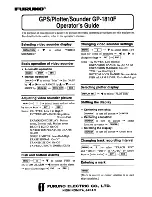
3
WIRELESS SYSTEMS
(*)
mod. MA155-T1, MA155-T2, MA155-T3, MA155-T4.
(*)
mod. MA155-T1, MA155-T2, MA155-T3, MA155-T4.
2. PREPARING THE TRANSMITTER
After removing the transmitter from its packaging, open the lid of the
battery compartment [
4
] by levering it off with a coin or a screwdriver,
as illustrated in Figure 2.1, and insert a 9V type PP3 battery, making
sure that the polarity is correct. Close the compartment by putting
the plastic lid removed earlier back into place.
3. SWITCHING ON AND TESTING THE BATTERY
To switch on the transmitter, move the ON/OFF switch [
2
] to the
intermediate position. At the same time, check that the signalling
lamp [
3
] lights up. This will mean that the battery has been correctly
inserted and that it is charged. If the lamp does not light up, check
the polarity of the battery or replace it, since it is no longer able to
supply any energy whatsoever.
4. USING THE TRANSMITTER
After switching on the radio-microphone transmitter, make sure that
its receiver is hooked up to the signal being transmitted (refer to the
instructions of the receiver in this respect). To enable the audio
signal of the microphone capsule, move the ON/OFF switch [
2
] to the
ON
position. Adjust the sound level as required by means of the
input volume control of the mixer or amplifier to which the radio-
microphone system is connected. To mute the microphone capsule,
move the switch [
2
] to the intermediate position. Once you have
finished using the radio-microphone system, always switch the
transmitter off by moving the ON/OFF switch [
2
] to the
OFF
position.
This will enable the battery to remain charged. If the transmitter is
not used for long periods of time, it is a good rule to remove the
battery from its compartment in order to avoid oxidising or leakage of
acid from the battery itself.
6. TIPS
Following are a few tips for using the radio-microphone system to
your full satisfaction:
6.1
Always keep the efficiency of the battery inserted inside the
transmitter under control.
6.2
Always keep the squelch level of the receiver as low as possible,
compatibly with the operating conditions (operating range,
obstacles, charge of the transmitter battery).
6.3
Carry out a trial with the transmitter in the area concerned, in
order to check whether there are any skip areas. If necessary,
identify the best direction for the aerials of the receiver and
reposition it in a place that provides better reception.
6.4
During the inspection referred to under point 6.3, also check
whether there is any acoustic feedback (Larsen effect). If there
is, we recommend using one or more of the following methods
in order to eliminate it:
positioning the loudspeakers so that they point in a different
direction;
increasing the distance between the area where the
transmitter is being used and the closest loudspeakers;
lowering the level of the volume of the broadcasting system.
2. PREPARAZIONE DEL TRASMETTITORE
Dopo aver tolto il trasmettitore dalla confezione, aprire il coperchio
del vano batteria [
4
] facendo leva con una moneta od un giravite,
come illustrato in figura 2.1, ed inserire una batteria da 9V tipo PP3
osservandone la corretta polarità. Richiudere il vano con il proprio
coperchio di plastica precedentemente rimosso.
3. ACCENSIONE E TEST DELLA BATTERIA
Per mettere in funzione il trasmettitore, portare linterruttore di
accensione [
2
] in posizione intermedia. Nel contempo, verificare che
la spia luminosa [
3
] si illumini; ciò sta a significare che la batteria e
inserita correttamente ed è carica; in caso contrario verificare la
corretta polarità di inserzione della pila oppure sostituirla, in quanto
non più in grado di fornire la benché minima energia.
5. USO DEL TRASMETTITORE
Dopo aver acceso il trasmettitore radiomicrofonico, accertarsi che il
relativo ricevitore sia agganciato al segnale trasmesso (in proposito
fare riferimento alle istruzioni del ricevitore). Per abilitare il segnale
audio della capsula microfonica, portare linterruttore di accensione
[
2
] in posizione
ON
; regolare, a seconda delle necessità, il livello
sonoro tramite il controllo di volume di ingresso del mixer o
dellamplificatore a cui è collegato il sistema radiomicrofonico.
Per silenziare la capsula microfonica portare linterruttore [
2
] in
posizione intermedia. Terminato luso del sistema radiomicrofonico,
spegnere sempre il trasmettitore portando linterruttore di accensione
[
2
] in posizione
OFF
; ciò consente di preservare la carica della
batteria. Se il trasmettitore non viene utilizzato per lunghi periodi di
tempo, è buona norma togliere la batteria dal proprio vano, onde
evitare eventuali ossidazioni o perdite di acido da parte della batteria.
6. SUGGERIMENTI
Diamo ora alcuni suggerimenti per poter utilizzare con piena
soddisfazione il sistema radiomicrofonico:
6.1
Tenere sempre sotto controllo lefficenza della batteria inserita
nel trasmettitore.
6.2
Mantenere sempre al livello più basso possibile il livello di squelch,
compatibilmente con le condizioni operative (portata utile,
ostacoli, livello della batteria del trasmettitore).
6.3
Effettuare una ricognizione con il trasmettitore nella zona di
interesse per verificare che non vi siano buchi di ricezione;
eventualmente, cercare il miglior orientamento delle antenne del
ricevitore e riposizionarlo in una zona migliore per la ricezione.
6.4
Durante lispezione di cui al punto 6.3, verificare anche leventuale
presenza di retroazione acustica (effetto Larsen). Per eliminare
questo fenomeno, si consiglia di utilizzare uno o più dei seguenti
metodi:
orientare in modo differente i diffusori acustici;
aumentare la distanza tra la zona di uso del trasmettitore e i
diffusori più vicini;
diminuire il livello di volume dell impianto di diffusione.
4. PILOT TONE (*)
The operation of this wireless microphone system is based on the
detection and identification of a specific signal, the so-called pilot
tone, sent by the transmitter together with the carrier frequency.
The squelch circuit therefore only activates the receiver if the level
of the signal received by both aerials is higher than the threshold
level that has been set, and only if the pilot tone is detected.
This prevents rustling and other background noise generated by
unwanted signals picked up by the aerials from reaching the
broadcasting system.
4. TONO PILOTA
(*)
Il sistema radimicrofonico basa il suo funzionamento sulla rilevazione
ed identificazione di un particolare segnale, detto tono pilota, inviato
dal trasmettitore con la frequenza portante.
Il circuito di ammutolimento, pertanto, attiva il ricevitore solamente
se il livello di segnale ricevuto da entrambe le antenne è superiore al
livello di soglia impostato e solo se viene rilevato il tono pilota. In
questo modo, si evita che all'impianto di diffusione giungano fruscii e
rumori di fondo generati da segnali indesiderati captati in antenna.
11-552.p65
17/01/02, 14.41
3
All manuals and user guides at all-guides.com


























